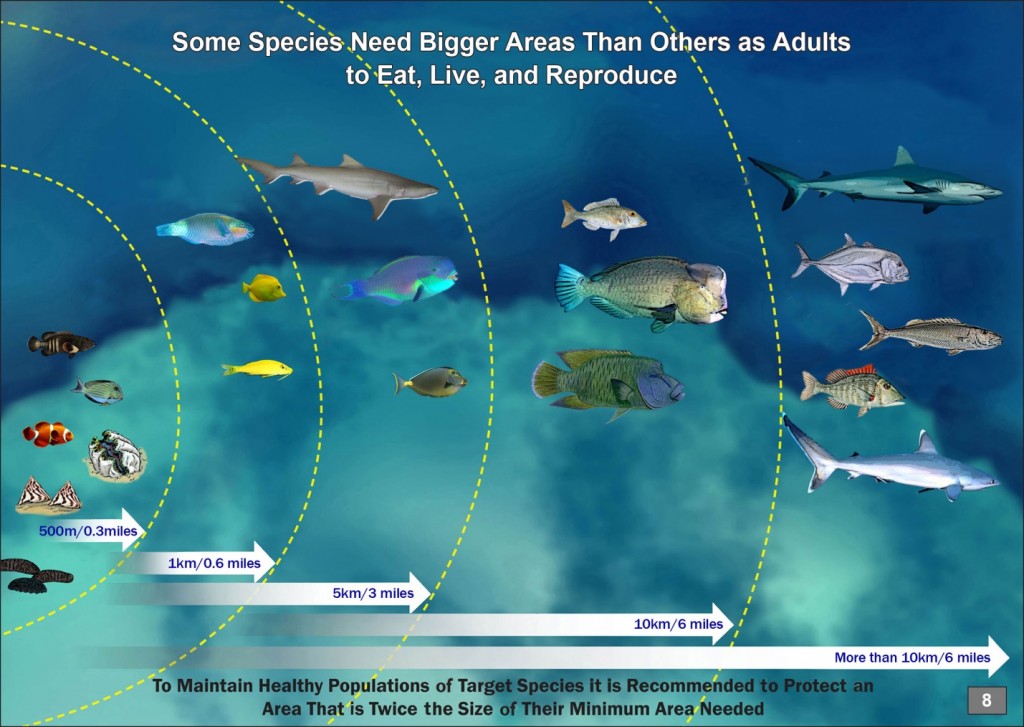Connectivity
Principle 4:
Maintenance of ecological connectivity among and between habitats.
Connectivity refers to the extent to which populations are linked by the exchange of eggs, larval recruits, juveniles, or adults. It also refers to the ecological linkages associated with adjacent and distant habitats. Connectivity within and between protected areas is important for maintaining diversity, fish stocks, and especially important for maintaining ecological resilience.
A network of MPAs should maximize connectivity between individual MPAs to ensure the protection of ecological functionality and productivity. Connectivity and ecological linkages include:
- Connections through regular larval dispersal in the water column between and within MPA sites
- Regular settlement of larvae from one MPA to another
- Marine organisms in their home range, and movement from one site to another
- Connections of linked habitats such as coral reefs and seagrass beds, or among mangrove and seagrass nursery areas and coral reefs
Connectivity between protected areas and areas open to fishing is also critically important to support local fisheries through spillover of adults, juveniles, and larvae to fished areas. ref

MPA Network in Raja Ampat, Indonesia. Photo © Joseph Orsi/TNC Photo Contest 2019
Design Recommendations
Sizing
Apply minimum sizes to protected areas within the network
- Apply minimum sizes to marine reserves, depending on which species require protection, how far they move, and if other effective management is in place outside reserves (e.g., 0.5-1 km and 5-20 km across). ref
- Marine reserves should be more than twice the size of the home range of focal species (in all directions).
- If the objective is to protect all species, then it is important to have large areas (smaller areas can provide benefits for some species that don’t move very far); for biodiversity protection, the recommended size is 10-20 km long. ref
- Where larval dispersal patterns and/or adult movement patterns of particular target species are known, this information can also inform decisions about ideal sizes of protected areas.
- Protect key habitats used by focal species throughout their lives (e.g., for home ranges, nursery areas, and fish spawning aggregations) in marine reserves, and ensure reserves are spaced to allow for movements among them (e.g., ontogenetic habitat shifts, spawning migrations). ref
- Include whole ecological units (e.g., offshore reefs) in marine reserves.
Spacing
Apply a variety of spacing distances between protected areas within the network
- Space marine reserves 1–15 km apart, with smaller reserves closer together.
- For temporal closures of any kind: Other types of protected areas (e.g., spatial gear or access restrictions) might be quite large in extent (e.g., throughout the management area), and so it may not make sense to have specified “distances” between them. However, if other permanent protected areas are isolated “islands” of protection, then the same spacing rules (and rationale) apply as no-take areas.
Location
- Larval sources are temporally variable and difficult to identify. So if there is a strong, consistent, unidirectional current, a greater number of marine reserves should be located upstream relative to fished areas. ref
- Ensure that MPAs are located in habitats that focal species use. ref
Shape
Use square or circular shapes for MPAs subject to considerations of compliance (e.g. including using landmarks)
- Use compact shapes (e.g., squares or circles rather than elongated ones) for MPAs subject to considerations of compliance (e.g. including using landmarks).
- Squares and circles allow for limited adult spillover, which helps maintain the integrity of the protected areas and, therefore, the sustainability of their contribution to fisheries production, biodiversity, and ecosystem resilience. Other shapes (e.g. long and thin) may facilitate more spillover to fished areas.
- The shape of an MPA is a critical factor in effective delineation and enforcement. MPAs with regular shapes can be delineated by lines of latitude and longitude and are more easily enforceable. MPAs of irregular shapes are not easily identifiable or enforced and should be avoided.
Many fish, invertebrates and corals release great numbers of eggs and young into the open ocean. The pelagic larvae can remain floating or moving through ocean currents for hours, days, or even months, traveling distances of thousands of kilometers prior to settling. Many factors influence larval dispersal that act synergistically. Factors influencing larval dispersal include:
- Larval behavior: swimming speed and directional capabilities of larvae are highly species-specific
- Larval duration: amount of time larvae spend in the open ocean is also species-specific; ranging from hours to months, and typical pelagic duration is 28-35 days ref
- Food resources: amount of available food during the pelagic duration
- Predators encountered: predators affect larval survival, condition, and growth rates
- Influences of currents or other oceanographic factors
Recent studies also show huge variability in larval dispersal distances, and lower dispersal distances than previously thought (e.g., 100 m to 1 km to 30 km). ref For example, larval dispersal distance in coral reef fishes tend to be 5-15 km and self-recruitment is common. ref Therefore, reserve spacing should be < 15 km with smaller reserves spaced more closely. Connectivity among populations of reef species is primarily, or for sessile species exclusively, due to dispersal during larval life. For most reef species that have been studied, demographic connectivity has been shown to act on scales of up to tens of kilometers, rather than on scales of hundreds of kilometers or more. This local-scale pattern of self-recruitment and connectivity among reefs has implications for the sizes required for MPAs within a network and may indicate that even small MPAs may be self-sustaining. Additionally, recent research on the Great Barrier Reef demonstrates that well protected marine reserve networks can make a significant contribution to the replenishment of fish populations both within the reserve and on adjacent fished reefs. ref
Adult movement is generally at a smaller scale than larval movement. Adult species movement patterns vary greatly among species. To protect a range of species within a MPA, a range of adult movement patterns need to be considered in MPA network design. The amount of protection a MPA provides for a species depends (to some degree) on movement habits and distances of the individual (both as adult and larvae). ref If adults move widely, the ocean neighborhood is large and diffuse. If adults are sessile, then the ocean neighborhood might be small and distinct.

Gombos et al. 2013 ref; modified from Maypa 2012 ref
Connectivity is important for supporting ecological processes (e.g., herbivory) that promote reef resilience. For example, connectivity between coral reefs and mangroves can increase grazing of herbivorous fish on adjacent reefs. ref Herbivorous fish remove algae, which promotes coral growth and reef resilience. Mangroves in the Caribbean have been shown to increase the resilience of offshore coral reefs in response to disturbances such as hurricane damage. ref After a disturbance event on a reef, macroalgae may out-compete corals for space, so maintaining healthy populations of fish that eat algae is critical for coral reef recovery. Mangroves support increased biomass of fish that eat macroalgae; thus, connectivity between mangroves and reefs can help corals recover from disturbance and enhance their rates of recovery. ref
The following adjacent habitat types should be considered in the design of the MPA network:
Reef Flats
Corals on reef flats and upper reef crests exposed at low tides often exhibit stress tolerance and may resist or recover rapidly from bleaching. They will be important providers of larvae that may settle in dead areas and aid their recovery.
- Reef flats often provide vital nurseries for reef fishes that will move onto the reef and help reestablish communities affected by bleaching.
- Nitrogen and organic materials produced on reef flats or transported from there in the form of feces of herbivorous fishes and other organisms, contribute valuable nutrients to the reef community. The transfer of materials aids in the overall functioning and recovery of the system.
Back-reef Lagoons
Coral assemblages in back-reef lagoons, especially shallow lagoons behind fringing reefs, are routinely exposed to wide temperature fluctuations. Consequently, the corals may exhibit some acclimatization to temperature stress and resistance to bleaching.
- Back-reef lagoons can serve as important nurseries for fish.
- Corals in naturally turbid, deeper lagoons may display higher resistance to bleaching than corals of the same species in clear waters over barrier reefs.
Seagrass Beds and Sand Flats
Seagrass beds and sand flats surrounding coral reefs are important feeding grounds for nocturnal fishes, such as snappers and grunts, which take shelter on reefs by day. After feeding in the seagrass beds and sand flats, the fish return to the reef, and deposit nutrients (to the reef food web) and contribute to the growth and recovery of reef communities.
Mangroves
The generally turbid waters and shading effect of mangroves may reduce the susceptibility of adjacent corals to bleaching. For more information and guidance on resilience and mangroves refer to Managing Mangroves for Resilience to Climate Change.
- When near reefs, mangroves can provide feeding grounds to fishes that take shelter on the reefs.
- Mangroves introduce fixed nitrogen and organic detritus into the coral reef food chain, as do reef flats and seagrass beds.
- Mangroves can provide intermediate nursery habitat between seagrass beds and patch reefs that increase the survival of young fish, thus mangroves can strongly influence the community structure of fish on adjacent coral reefs. ref
- Research in the Caribbean demonstrated that the biomass of several commercially important fish species more than doubled when adult habitat was connected to mangroves, reinforcing the need for conservation efforts to protect connected corridors of mangroves, seagrass beds, and coral reefs. ref More recent studies in Australia also demonstrate that connectivity between reefs and mangroves in reserves promotes the abundance of harvested fish species. ref
Connectivity and Ecological Processes
Recent studies discuss the importance of incorporating connectivity into conservation planning. ref These case studies demonstrate how ecological processes (e.g., connectivity among habitats) can be integrated into decision support tools such as reserve selection algorithms (e.g., MARXAN) to help improve the performance of protected areas. Such efforts are important to help managers integrate ecosystem-based management into the design of marine protected areas.
Read the latest guidance on integrating larval dispersal and movement patterns of coral reef fishes into the design of marine reserves.
